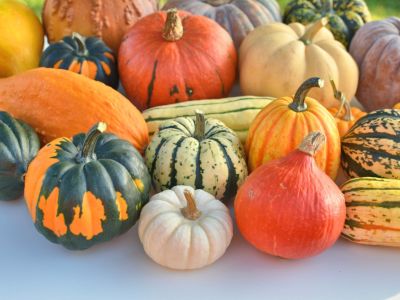Varieties of Squash
There are many varieties of squash, most of which are vine plants; there are a number of bush types as well, however. Before you grow squash, be sure you know which type you have and plan your garden accordingly. There are two types of squash varieties: summer and winter. Summer varieties of squash are large and bushy. These types of plants do not spread as the vine types do. There are several types of summer squash which come in a variety of shapes and colors. The most common types include:
Straight-neck Crooked-neck Scallop Zucchini
Most winter varieties of squash are vine plants and will spread throughout the garden. Winter squash is often categorized according to fruit size and there are a number of sizes, shapes, and colors available. Winter varieties include:
Acorn Butternut Spaghetti Hubbard
Growing Squash Tips
As with other vine-growing crops, squash prefers heat, but it is often somewhat hardier than melons or cucumbers. Squash plants require full sun, fertile soil, and sufficient moisture. The use of well composted material mixed into the soil is recommended. Summer and winter squash grow best in fertile, well-drained soil containing high amounts of organic matter in areas of full sun. Organic matter can be added by incorporating compost into the soil as well as decomposed manure. Squash can be sown directly into the garden or started indoors. Summer and winter squash are commonly planted in hills about 1 inch (2.5 cm.) deep. Sow seeds only after any danger of frost has ended and the soil has warmed. Usually, only 4 to 5 seeds per hill is plenty, thinning down to 2 or 3 plants per hill once the seedlings have developed their true leaves. Hills and rows of summer squash should be approximately 3 to 4 feet (1 m.) apart, while winter squash should be spaced approximately 4 to 5 feet (1-1.5 m.) apart with 5 to 7 feet (1.5-2 m.) between rows and with the hills spaced about 3 feet (1 m.) apart. Squash can be started indoors 3 to 4 weeks prior to the planting date. Start seeds in peat pots, but be sure the squash seedlings do not suffer root disturbances during transplanting. You can plant 3 to 4 seeds per pot and thin to 2 plants later. Be sure to harden the plants off prior to planting in the garden to lessen the shock of transplanting and wait until all danger of frost has passed. It helps to mulch squash plants generously; mulching maintains moisture and reduces weeds.
Harvesting Squash
Check daily when harvesting squash plants, as these crops grow quickly, especially in hot weather. You should harvest squash frequently to encourage more production and pick the fruits while still small. Squash that is overly ripe becomes hard, seedy, and loses its flavor. The summer varieties should be gathered before the seeds have fully ripened and while the rinds are still soft. The winter varieties should not be picked until well matured. Summer squash can be stored cool, moist areas up to two weeks. They may also be canned or frozen. Summer squash is commonly used in salads, stir-fried, steamed, or cooked in various dishes. Winter squash can be stored in a cool, dry location for 1 to 6 months. Winter squash is commonly used in baked, steamed, or boiled dishes.
Growing Squash Problems
Most varieties of squash are susceptible to a variety of bacteria and fungal diseases. Powdery mildew and bacterial wilt are the most common. Disease problems are most common in hot and humid weather. These diseases can be treated with organic fungicides. A variety of other pests also can cause problems, depending on your particular area. Squash bugs and squash vine borers can be serious pests. These insects can cause entire leaves to wilt, turn brown, and die. Squash is also susceptible to cucumber beetles, which feed on the leaves of the plants and spread disease from one plant to another. Most adult insects can be easily removed by hand, or you may apply an appropriate insecticide to the base of the plants. With proper garden planning, growing requirements, and maintenance, many of these problems can be avoided. After the final harvest, remove and destroy all plant debris to prevent insect or disease infestations.
